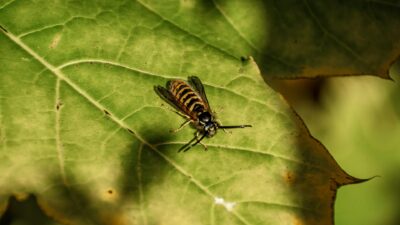Beneficial insects are nature’s pest control experts, helping organic gardeners keep harmful pests in check without chemicals. These helpful creatures prey on or parasitize pests, creating a balanced ecosystem in your garden. By attracting and supporting beneficial insects, you can reduce pest damage while promoting biodiversity. This guide explains how to use beneficial insects for organic pest control, from identifying them to creating a welcoming habitat. For more organic gardening tips, explore For Organic Life.
Identifying Helpful Insects
Not all insects are pests—many are allies in your garden. Here are some common beneficial insects and the pests they target:
- Ladybugs: Both adults and larvae eat aphids, mites, and whiteflies. A single ladybug can consume up to 5,000 aphids in its lifetime.
- Lacewings: Green lacewing larvae, known as “aphid lions,” feed on aphids, caterpillars, and mealybugs.
- Predatory Beetles: Ground beetles eat slugs, snails, and caterpillars, often hunting at night.
- Parasitic Wasps: These tiny wasps lay eggs in pests like caterpillars or aphids, killing them as larvae develop.
Learn to recognize these insects to avoid mistaking them for pests. For example, lacewing larvae look like small alligators, while ladybug larvae are spiky and black with orange spots. Use online guides or local extension services to identify beneficial insects in your area. Knowing your allies helps you protect them while they work.
Creating Habitats to Attract Beneficial Insects
Beneficial insects need food, water, and shelter to thrive. Create a garden habitat that meets their needs to encourage them to stay. Here’s how:
- Plant Diversity: Grow a mix of plants with different bloom times to provide nectar and pollen year-round. Small flowers, like those of dill or fennel, are easy for tiny insects to access.
- Shelter: Leave some areas undisturbed, like piles of leaves or logs, for ground beetles to hide. Native grasses or low shrubs offer overwintering spots.
- Water Sources: Place shallow dishes with pebbles and water in sunny spots. Insects like ladybugs need water but can drown in deep containers.
- Avoid Tilling: Excessive tilling disrupts ground-dwelling insects like predatory beetles. Use no-till methods to protect their habitats.
You can also install insect hotels—small structures filled with wood, straw, or bamboo—to provide nesting sites. Place them in sunny, sheltered areas. A welcoming habitat ensures beneficial insects stick around to patrol your garden.
Plants That Support Beneficial Insect Populations
Certain plants are magnets for beneficial insects, providing nectar, pollen, or shelter. Include these in your garden to boost insect populations:
- Yarrow: Its flat flower heads attract lacewings, ladybugs, and parasitic wasps.
- Dill: A favorite of hoverflies and predatory wasps, with nectar-rich flowers.
- Sunflowers: Their large blooms draw pollinators and predatory insects like ladybugs.
- Clover: A low-growing ground cover that supports ground beetles and parasitic wasps.
Plant these near your crops to create a pest-control network. For example, yarrow near tomatoes can attract ladybugs to eat aphids. Scatter these plants throughout your garden or create dedicated insectary beds. Native plants are especially effective, as local insects are adapted to them. Check with local nurseries for region-specific options.
Avoiding Practices That Harm Beneficial Insects
To keep beneficial insects safe, avoid practices that harm them. Synthetic pesticides, even in small amounts, can kill helpful insects like ladybugs or lacewings. Stick to organic methods, such as neem oil or soap sprays, and apply them carefully in the evening when beneficial insects are less active.
Over-cleaning your garden can also hurt beneficial insects. Leaving some leaf litter or dead stems provides winter shelter for predatory beetles and lacewings. Avoid broad-spectrum organic pesticides, like pyrethrum, which can harm non-target insects. If you must treat pests, target only affected plants to minimize impact.
Mowing or trimming flowering plants too early can cut off food sources. Let plants like clover or dill bloom fully before cutting back. By gardening mindfully, you protect the insects that protect your crops.
Monitoring Insect Balance in Your Garden
A healthy garden has a balance of pests and beneficial insects. Monitor your garden to ensure this balance is maintained. Check plants weekly for pest damage, like chewed leaves or sticky residue, and look for beneficial insects or their signs, like lacewing eggs (tiny white threads on leaves).
If pest populations are high but beneficial insects are scarce, introduce more helpers. You can buy ladybugs or lacewings from organic suppliers, but release them in the evening near infested plants to encourage them to stay. If pests persist, boost your habitat with more nectar plants or water sources.
Keep a journal to track insect activity and plant health. Note which pests decline and which beneficial insects appear. Over time, a balanced garden needs less intervention as beneficial insects keep pests in check naturally.
Harnessing Nature’s Pest Control
Beneficial insects are powerful allies in organic gardening, reducing pests while keeping your garden chemical-free. By identifying helpful insects, creating inviting habitats, planting supportive crops, avoiding harmful practices, and monitoring balance, you can build a thriving ecosystem. Experiment with different plants and habitats to see what attracts the most helpers. For more eco-friendly gardening ideas, visit For Organic Life. Let nature do the work, and enjoy a healthier, pest-resistant garden!




